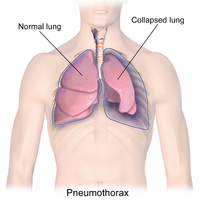
Photo from wikipedia
Currently early diagnosis of malignant lesions at the periphery of lung parenchyma requires guidance of the biopsy needle catheter from the bronchoscope into the smaller peripheral airways via harmful X-ray… Click to show full abstract
Currently early diagnosis of malignant lesions at the periphery of lung parenchyma requires guidance of the biopsy needle catheter from the bronchoscope into the smaller peripheral airways via harmful X-ray radiation. Previously, we developed an image-guided system, iMTECH which uses electromagnetic tracking and although it increases the precision of biopsy collection and minimizes the use of harmful X-ray radiation during the interventional procedures, it only traces the tip of the biopsy catheter leaving the remaining catheter untraceable in real time and therefore increasing image registration error. To address this issue, we developed a shape sensing guidance system containing a fiber-Bragg grating (FBG) catheter and an artificial intelligence (AI) software, AIrShape to track and guide the entire biopsy instrument inside the lung airways, without radiation or electromagnetic navigation. We used a FBG fiber with one central and three peripheral cores positioned at 120° from each other, an array of 25 draw tower gratings with 1cm/3nm spacing, 2 mm grating length, Ormocer-T coating, and a total outer diameter of 0.2 mm. The FBG fiber was placed in the working channel of a custom made three-lumen catheter with a tip bending mechanism (FBG catheter). The AIrShape software determines the position of the FBG catheter by superimposing its position to the lung airway center lines using an AI algorithm. The feasibility of the FBG system was tested in an anatomically accurate lung airway model and validated visually and with the iMTECH platform. The results prove a viable shape-sensing hardware and software navigation solution for flexible medical instruments to reach the peripheral airways. During future studies, the feasibility of FBG catheter will be tested in pre-clinical animal models.
Journal Title: PLOS ONE
Year Published: 2022
Link to full text (if available)
Share on Social Media: Sign Up to like & get
recommendations!